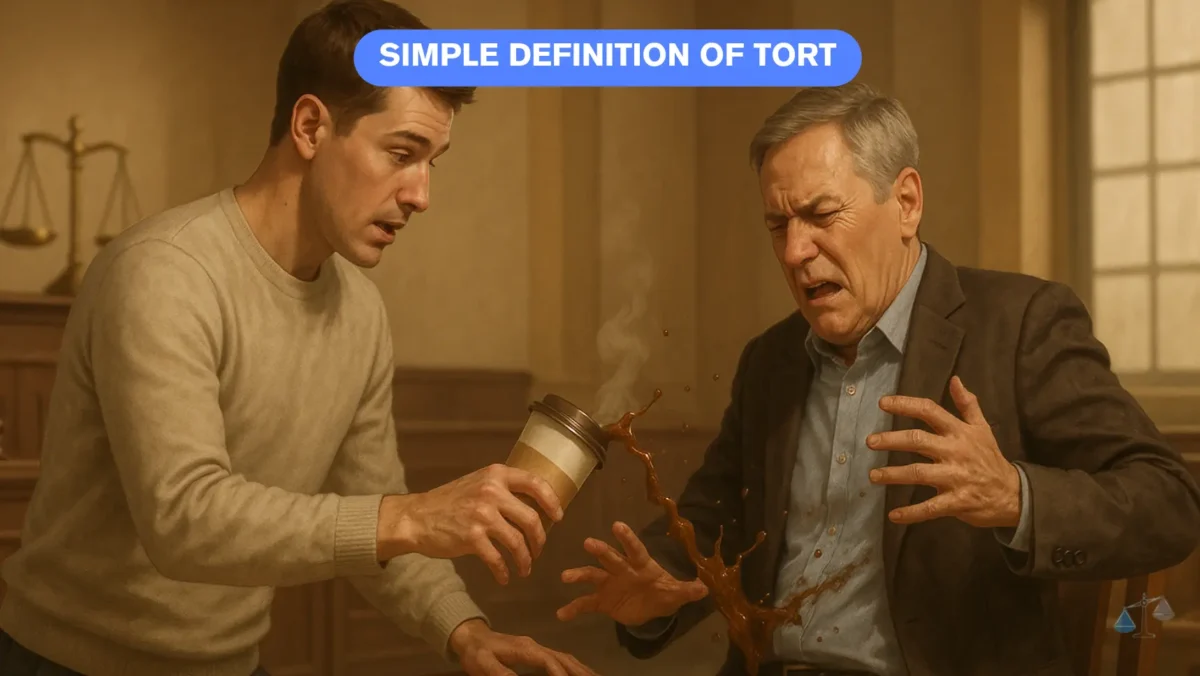What Is a Tort? Simple Definition and Meaning in Law

Simple definition of a tort: a wrongful act or omission that causes harm or injury to another person, for which the injured party may seek legal remedy, typically in the form of monetary compensation. Tort law governs civil wrongs — not crimes or contract breaches — and aims to restore victims to their previous position through damages or equitable relief.
“A tort isn’t a crime; it’s a civil wrong that costs money, not freedom.”
Meaning of a Tort in Law
A tort is a legal wrong that occurs when one person’s conduct unfairly causes someone else to suffer harm or loss. Unlike criminal law, which punishes offenders, tort law focuses on compensating victims. The person who commits the wrong is known as the tortfeasor, while the injured person is the plaintiff.
Tort law rests on three core elements:
- A legal duty owed by one person to another.
- A breach of that duty through act or omission.
- Resulting harm or damages caused by that breach.
If all three elements are proven, the injured party may receive compensation through a civil lawsuit. This framework ensures accountability in everyday activities — driving, manufacturing products, publishing information, or providing services — where negligence or misconduct can cause harm.
Tort law is a foundation of civil justice systems worldwide, reflecting society’s commitment to fairness, responsibility, and deterrence.
How Tort Law Works in Legal Systems
The legal structure of torts is primarily case law–driven, shaped by centuries of judicial precedent. Modern tort systems are divided into several categories, each defining a specific type of wrongful conduct.
Major Categories of Torts
| Type | Description | Example |
|---|---|---|
| Intentional Torts | Deliberate acts intended to harm another | Assault, battery, false imprisonment |
| Negligence | Failure to exercise reasonable care | Car accidents, medical malpractice |
| Strict Liability | Liability without fault, often in hazardous activities | Defective products, keeping wild animals |
| Defamation | False statements that harm reputation | Libel (written), slander (spoken) |
| Nuisance | Unreasonable interference with property use or enjoyment | Noise pollution, toxic fumes |
Each category carries distinct rules for establishing fault and calculating damages. For instance, negligence requires proof that the defendant breached a duty of care, while strict liability imposes responsibility even when reasonable precautions were taken.
Tort law often interacts with other legal areas, including insurance, contract, and criminal law, especially when the same act may give rise to multiple claims.
Everyday Situations Where Tort Law Applies
Tort law affects nearly every aspect of daily life — from traffic safety to product design, workplace standards, and online communication. Whenever harm occurs outside a contractual or criminal context, tort principles usually apply.
Common Real-World Examples:
- Negligence: A driver runs a red light and injures another motorist.
- Medical Malpractice: A doctor fails to diagnose a condition that another competent physician would have detected.
- Defamation: A journalist publishes false statements damaging someone’s reputation.
- Product Liability: A manufacturer sells a defective appliance that causes injury.
- Trespass: Someone enters another’s land without permission, causing damage.
In each case, the injured party may sue for damages such as:
- Compensatory Damages – covering actual losses (medical bills, property damage, lost income).
- Punitive Damages – punishing severe misconduct and deterring future wrongdoing.
- Nominal Damages – acknowledging a legal wrong even without significant loss.
The primary goal is restoration, not punishment. Tort law provides a framework for individuals to hold others accountable, balancing personal responsibility with social order.
Why Tort Law Matters: Legal and Social Significance
Tort law matters because it protects individuals’ rights and enforces social responsibility. It fills the gap between criminal and contract law by addressing private wrongs that don’t involve the state directly.
Why Tort Law Is Essential:
- Promotes Accountability: People must act responsibly to avoid harming others.
- Compensates Victims: Provides a pathway for injured parties to recover losses.
- Encourages Prevention: Fear of liability motivates safer behavior.
- Maintains Order: Reduces the need for personal retaliation or vigilante justice.
Beyond individual cases, tort law shapes industries — from healthcare to manufacturing — by setting safety and quality standards. Courts’ decisions influence how companies test products, warn consumers, and handle risk.
Ultimately, tort law represents a balance between freedom of action and duty of care — the idea that everyone is free to act, so long as they don’t unreasonably harm others.
Limitations and Evolving Challenges
Despite its importance, tort law faces criticism for inconsistency and rising litigation costs. Damage awards can vary widely, and proving fault is not always straightforward.
New technological and social issues — such as AI liability, data breaches, and environmental harm — are pushing courts to adapt old tort principles to modern realities.
Key limitations include:
- Difficulty quantifying non-economic harm (like emotional distress).
- Potential for frivolous lawsuits or excessive verdicts.
- Jurisdictional differences leading to inconsistent outcomes.
- Insurance-driven settlements that may undervalue actual harm.
Still, tort law continues to evolve as courts refine standards of care and adapt to emerging risks.
FAQ — Tort Law
What is the simple definition of a tort?
A tort is a wrongful act or omission that causes harm or injury to another person. The harmed party can bring a civil lawsuit to seek compensation or other remedies for the damage caused.
What are the main types of torts?
There are three major categories:
Intentional torts, such as assault or trespass, where harm is deliberate.
Negligence, where harm results from careless behavior.
Strict liability, where responsibility exists regardless of fault, such as defective products or dangerous animals.
How is a tort different from a crime?
A tort is a civil wrong, while a crime is an offense against the state. Torts result in compensation for the victim; crimes lead to punishment like fines or imprisonment. The same act, however, can sometimes be both a tort and a crime.
What must be proven in a tort case?
The plaintiff must prove:
The defendant owed a legal duty.
The defendant breached that duty.
The breach caused harm or injury.
The plaintiff suffered measurable damages.
What is negligence in tort law?
Negligence occurs when someone fails to act with the level of care that a reasonable person would exercise in similar circumstances, resulting in harm to another.
Can emotional distress be a tort?
Yes. “Intentional infliction of emotional distress” and “negligent infliction of emotional distress” are recognized torts when the defendant’s actions cause serious psychological harm.
What damages can be awarded in tort cases?
Courts may award compensatory damages (to cover losses), punitive damages (to punish severe misconduct), and nominal damages (to acknowledge a legal wrong with minimal harm).
Is defamation a tort?
Yes. Defamation—false statements that harm a person’s reputation—is a tort, divided into libel (written) and slander (spoken). Plaintiffs must prove falsity and harm to reputation.
Can corporations commit torts?
Yes. Businesses can be held liable for torts committed by their employees or defective products. This is common in negligence and strict liability cases.
Why is tort law important in society?
Because it protects people from harm, encourages responsible behavior, and ensures fair compensation for injuries. Tort law helps maintain balance between individual freedom and public safety.
Author Note
Author: Legal Terms
Last Updated: October 10, 2025
Disclaimer: This article explains tort law and its principles for general educational purposes only. It does not constitute legal advice.
Table Of Contents
Keywords
- What Is a Tort?
- Meaning of a Tort in Law
- Simple Definition of Tort
- How Tort Law Works in Legal Systems
- Major Categories of Torts
- Everyday Situations Where Tort Law Applies
- Why Tort Law Matters
- Limitations and Evolving Challenges






